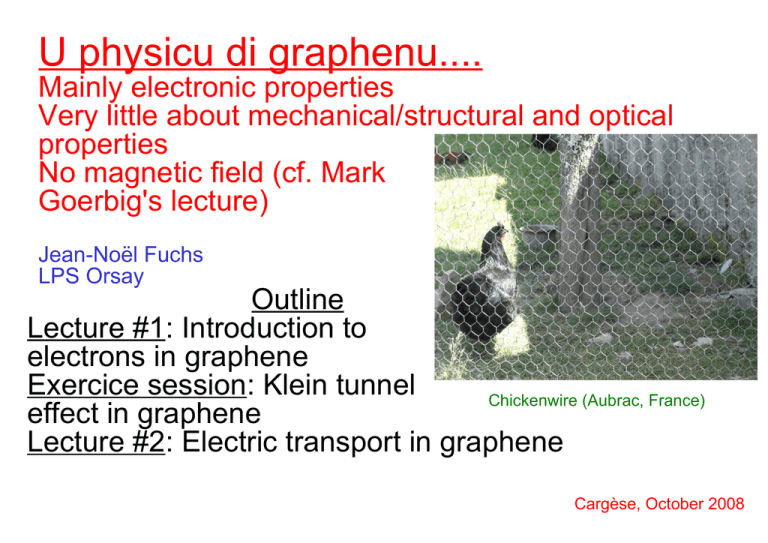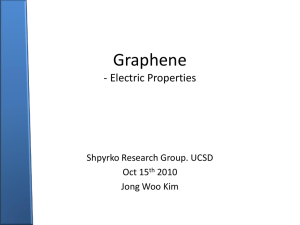J.-N. Fuchs, Cours 1 - Laboratoire de Physique des Solides
advertisement

U physicu di graphenu.... Mainly electronic properties Very little about mechanical/structural and optical properties No magnetic field (cf. Mark Goerbig's lecture) Jean-Noël Fuchs LPS Orsay Outline Lecture #1: Introduction to electrons in graphene Exercice session: Klein tunnel Chickenwire (Aubrac, France) effect in graphene Lecture #2: Electric transport in graphene Cargèse, October 2008 Lecture #1: Introduction to electrons in graphene Outline I) Introduction II) Short history III) Experimental techniques IV) Atomic structure V) Band structure RER B train station Denfert-Rochereau (Paris) VI) Low energy effective theory VII) “Relativistic” quantum mechanics in graphene VIII) The minimum about el-el interactions IX) Conclusion Cargèse, October 2008 I) Introduction: main ideas Direct space Graphene = 2D honeycomb carbon crystal (thickness of a single atom) Graphene’s magic comes from its peculiar band structure: - The valence (VB) and conduction bands (CB) meet in 2 (not 6) points (K,K’) in reciprocal space [Dirac points]. - The dispersion relation close to the Dirac points is linear [diabolo] and it has electronhole symmetry [charge conjugaison]. - The VB is full, the CB is empty: the Fermi level is right at the Dirac points. → Graphene is a 2 valleys (K,K') 2D gapless semiconductor. Electrons are massless and chiral. Reciprocal space CB 1Bz K K’ VB II) Short history II) Pre-history Experiments Graphite: light bulbs, nuclear moderator,.. 1962 HOPG (graphite monocrystal) [Ubbelohde] 1960-1980 Graphite intercalation compounds 1985 Fullerenes [Kroto, Curl, Smalley] 1991-1993 Carbon nanotubes [Iijima] 1992-1993 Graphene (uncontacted) on metal substrate [Land et al.] II) Modern history Experiments 2004 Contacted (and gated) graphene on amorphous SiO2 substrate [Novoselov, Geim] 2004 Epitaxial “graphene’’ on SiC [Berger, de Heer] 2005 Graphene quantum Hall effect [N.,G., Zhang,Kim] See M. Goerbig's lectures 2006 Graphene bilayer QHE [N.,G.,McCann, Falko] 2007 Suspended graphene [Meyer] 10/2008: about 1000 preprints in the arXiv since QHE II) History: theories 1947 Graphene band structure [Wallace] 1956 Graphene Landau levels [McClure] 1985 Hofstadter butterfly [Rammal] ε 1984-1988 Connection to 2+1 field theory [Semenoff, DiVicenzo & Mele, Fradkin, Haldane, etc.] ~90’s Theory of carbon nanotubes [Dresselhauss, Dresselhauss, Saito, Ando, etc.] ~2000 Early work on graphene [Guinea et al., Kane and Mele, Ando, etc.] Φ/Φ0 III) Experimental techniques III) Experimental techniques Two techniques: a) Mechanically exfoliated graphene Recipe: Take a (monocrystallite) graphite sample (HOPG). Remove layers with a scoth tape and then press it on a Si/SiO2 substrate: you will deposit graphite flakes. A small fraction are monolayers. Detect them with an optical microscope (300nm SiO2 thickness): that’s tough. Contact the monolayer with metallic leads (gold e.g.). Apply an electric tension to the heavily n-doped Si 2 backgate. graphene flake (~1 to 100 μm ) contacts (Au) n-Si 300nm of SiO2 Novoselov et al., Science 2004 and PNAS 2005 III) Experimental techniques Electric field effect: a gate tension Vg allows to control the filling on electrons in the graphene sheet ("doping" of graphene) Capacitor = plate(graphene)/dielectric(SiO2)/plate(n-doped Si) Novoselov et al., Science 2004 and PNAS 2005 typical mobility μ ~ 1 m2/V.s (record mobility ~ 20 m2/V.s in 2DEG ~ 1000 m2/V.s) typical density n ~ 1016 m-2 n/Vg = 7х1014 m-2/V Zhang et al., Nature 2005 III) Experimental techniques Suspended sheet and ripples Typical height ≤ 1 nm Typical length ~ tens of nm Meyer et al., Nature 2007 III) Experimental techniques b) Epitaxial graphene on SiC Berger et al., J. Phys. Chem. 2004 [de Heer’s group] IV) Atomic structure IV) Atomic structure Graphene = 2D honeycomb crystal of carbon Carbon atom: 6 electrons 1s2 (core) 2s2 2p2 (valence) hybridization: 1 × 2s orbital and 2 × 2p orbitals → 3 × sp2 orbitals 1 × 2pz orbital left - 3 coplanar σ bonds, with 120° angle: honeycomb structure - 1 conduction electron per C atom, 2pz orbital, perpendicular to the plane, giving π bands: electronic properties IV) Atomic structure Honeycomb crystal = triangular (2D) Bravais lattice + 2 atoms basis (important for Bloch’s theorem) Direct space: y B A A A B B B B B A x O A B B A A A B IV) Atomic structure Reciprocal space: Reciprocal lattice of the triangular lattice = triangular lattice (whatever the atomic basis) ky g1 g2 K K' K' Γ K K g1 K' 1st Brillouin zone (1Bz) kx IV) Atomic structure Conclusion: - Direct space: sublattice index g1 - Reciprocal space: valley index (has no connection to the 2 carbon atoms in the basis, but is related to the Bravais lattice) - First 2D crystal: they do exist and they are stable (however they are not flat but rippled). V) Band structure V) Band structure Nearest neighbor tight binding model for the conduction electrons [Wallace 1947] A B B g1 A origin V) Band structure B B A B 2×2 matrix in sublattice (A,B) space g1 +3t CB(α=+1) 0 K' -3t K VB(α=-1) V) Band filling CB 1Bz K’ VB g1 DoS εF=0 CB VB ε -3t -t 0 t εF 3t K V) Electron and hole puddles Martin et al., Nature Phys. 2008 VI) Low energy effective theory VI) Low energy effective theory g1 CB CB VB diabolo VB V) Density of states DoS εF=0 CB VB g1 -3t -t 0 VB ε t εF 3t VI) 2D massless Dirac Hamiltonian hk*≈vF p exp(i Arctg(py/px)) g1 quadri-spinor V) Dirac equation g1 Dirac 1928 V) Dirac 3+1 versus Weyl 2+1 g1 electron electron 2mc2 ε F =0 positron Dirac sea hole Fermi sea Dirac equation 1928 Weyl equation for neutrino 1929 Positron (Dirac 1930) Hole in semiconductors (Peierls 1929) VI) Effective theory: summary g1 VII) “Relativistic” quantum mechanics in graphene VII) Minimal localization length ΔE E 0 g1 VII) Chirality (helicity) and sublattice spin g1 K' - K + CB + - VB VII) Velocity, current and Zitterbewegung g1 Schrödinger 1930 VII) Absence of backscattering g1 0.6 p' 0.4 0.2 θ p 0.2 -0.2 -0.4 Ando, Nakanishi, Saito, J. Phys. Soc. Jpn 1998 -0.6 0.4 0.6 0.8 1 VIII) Minimum about el-el interactions VIII) Minimum about el-el interactions IX) Conclusions IX) Solid state physics’ conclusion: a peculiar solid - A 2D semiconductor but with zero gap: one cannot apply the standard theory of semiconductors (Δ=0). - A 2D metal but with zero density of states at the Fermi level g1 (when undoped): one cannot apply the standard theory of metals (ρ(εF)=0). - The electrons close to the Fermi level do not obey a Schrödinger equation with an effective mass. They obey a massless (2D) Dirac equation (m*=0). One cannot apply the standard transport theory. IX) "Relativistic" quantum mechanics' conclusion - Graphene is a 2D gapless semiconductor with 2 valleys (K,K': fermion doubling). - At low energy, its conduction electrons obey a 2D massless Dirac equation. Electron-hole symmetry + zero gap → chiral electrons. References - Popular scientific reviews: M. Wilson, Physics Today (January 2006), page 21; J.N. Fuchs, M.O. Goerbig, M. Potemski, Images de la physique (CNRS, 2007) et Pour la Science (mai 2008), page 36. - Recent reviews: A. Geim, K. Novoselov, Nature Materials 6, 183 (2007); A.H. Castro Neto, F. Guinea, N.M.R. Peres, K.S. Novoselov, A.K. Geim, arXiv:0709.1163 (to appear in Reviews of Modern Physics). - Two important experiments: Novoselov et al., Nature 438, 197 (2005) [Geim’s group] Zhang et al., Nature 438, 201 (2005) [Kim’s group].



